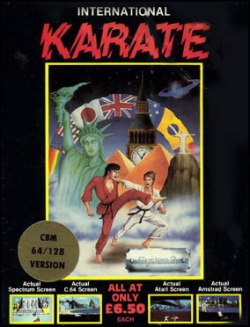International Karate
| International Karate | |
|---|---|

Commodore 64 cover art for International Karate
|
|
| Developer(s) | System 3 |
| Publisher(s) | System 3 (Europe), Epyx (United States) |
| Designer(s) | Archer MacLean |
| Composer(s) | Rob Hubbard |
| Platform(s) | Amstrad CPC, Apple II, Atari 8-bit, Atari ST, Commodore 64, Commodore 16, MS-DOS, MSX, ZX Spectrum, Game Boy Color, Game Boy Advance, Virtual Console |
| Release |
Spectrum
|
| Genre(s) | Fighting game |
| Mode(s) | Single-player, multiplayer |
International Karate is a karate fighting game created and published by System 3 for various home computers.
Epyx licensed and published the game in the US as World Karate Championship in April 1986. Except for a new loading screen and necessary tuning for the American NTSC television system, the US releases were unchanged.
International Karate + a successor which expanded the gameplay through the introduction of an additional - although not player controllable - karateka, was released in 1987. Through the unauthorized release of International Karate + Gold in 2001, this player was made controllable using a joystick adapter.
The core game is a two-dimensional, one-on-one, versus fighting game. Players take on the roles of martial artists competing in a kumite tournament. Rather than wearing down an opponent's health, the goal is instead to score single solid hits. After each hit, combat stops and both combatants are returned to their starting positions. Depending on how well players hit their opponent, they score either a half-point or a full point. Matches can be quite brief, as only two full points are required to win, and a point can be quickly scored just seconds after a round begins.
In single player mode, successive opponents increase in difficulty from novice white belts to master black belts. Play continues as long as the player continues to win matches. Between fights, bonus mini-games focusing on rhythm and timing appear, including one in which the player must break a number of stacked boards using only his or her head.
As in newer games in the genre, starting specifically with Street Fighter, the fights take place against a variety of backdrops (8 in total) representing different locations in the world.
...
Wikipedia
